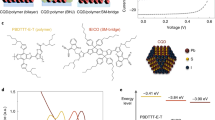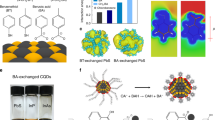Abstract
Bandtail states in disordered semiconductor materials result in losses in open-circuit voltage (Voc) and inhibit carrier transport in photovoltaics. For colloidal quantum dot (CQD) films that promise low-cost, large-area, air-stable photovoltaics, bandtails are determined by CQD synthetic polydispersity and inhomogeneous aggregation during the ligand-exchange process. Here we introduce a new method for the synthesis of solution-phase ligand-exchanged CQD inks that enable a flat energy landscape and an advantageously high packing density. In the solid state, these materials exhibit a sharper bandtail and reduced energy funnelling compared with the previous best CQD thin films for photovoltaics. Consequently, we demonstrate solar cells with higher Voc and more efficient charge injection into the electron acceptor, allowing the use of a closer-to-optimum bandgap to absorb more light. These enable the fabrication of CQD solar cells made via a solution-phase ligand exchange, with a certified power conversion efficiency of 11.28%. The devices are stable when stored in air, unencapsulated, for over 1,000 h.
This is a preview of subscription content, access via your institution
Access options
Subscribe to this journal
Receive 12 print issues and online access
$259.00 per year
only $21.58 per issue
Buy this article
- Purchase on Springer Link
- Instant access to full article PDF
Prices may be subject to local taxes which are calculated during checkout





Similar content being viewed by others
References
McDonald, S. A. et al. Solution-processed PbS quantum dot infrared photodetectors and photovoltaics. Nat. Mater. 4, 138–142 (2005).
Kamat, P. V. Quantum dot solar cells. Semiconductor nanocrystals as light harvesters. J. Phys. Chem. C 112, 18737–18753 (2008).
Luther, J. M. et al. Schottky solar cells based on colloidal nanocrystal films. Nano Lett. 8, 3488–3492 (2008).
Nozik, A. J. et al. Semiconductor quantum dots and quantum dot arrays and applications of multiple exciton generation to third-generation photovoltaic solar cells. Chem. Rev. 110, 6873–6890 (2010).
Konstantatos, G. et al. Ultrasensitive solution-cast quantum dot photodetectors. Nature 442, 180–183 (2006).
Lee, J.-S., Kovalenko, M. V., Huang, J., Chung, D. S. & Talapin, D. V. Band-like transport, high electron mobility and high photoconductivity in all-inorganic nanocrystal arrays. Nat. Nanotech. 6, 348–352 (2011).
Sun, Q. J. et al. Bright, multicoloured light-emitting diodes based on quantum dots. Nat. Photon. 1, 717–722 (2007).
Hoogland, S. et al. A solution-processed 1.53 μm quantum dot laser with temperature-invariant emission wavelength. Opt. Express 14, 3273–3281 (2006).
Chuang, C.-H. M., Brown, P. R., Bulović, V. & Bawendi, M. G. Improved performance and stability in quantum dot solar cells through band alignment engineering. Nat. Mater. 13, 796–801 (2014).
Lan, X. et al. Passivation using molecular halides increases quantum dot solar cell performance. Adv. Mater. 28, 299–304 (2016).
Ip, A. H. et al. Hybrid passivated colloidal quantum dot solids. Nat. Nanotech. 7, 577–582 (2012).
Tang, J. et al. Colloidal-quantum-dot photovoltaics using atomic-ligand passivation. Nat. Mater. 10, 765–771 (2011).
Ning, Z. et al. All-inorganic colloidal quantum dot photovoltaics employing solution-phase halide passivation. Adv. Mater. 24, 6295–6299 (2012).
Ning, Z. et al. Air-stable n-type colloidal quantum dot solids. Nat. Mater. 13, 822–828 (2014).
Lan, X. et al. 10.6% certified colloidal quantum dot solar cells via solvent-polarity-engineered halide passivation. Nano Lett. 16, 4630–4634 (2016).
Ip, A. H. et al. Infrared colloidal quantum dot photovoltaics via coupling enhancement and agglomeration suppression. ACS Nano 9, 8833–8842 (2015).
Carey, G. H., Levina, L., Comin, R., Voznyy, O. & Sargent, E. H. Record charge carrier diffusion length in colloidal quantum dot solids via mutual dot-to-dot surface passivation. Adv. Mater. 27, 3325–3330 (2015).
Yang, Z. et al. Colloidal quantum dot photovoltaics enhanced by perovskite shelling. Nano Lett. 15, 7539–7543 (2015).
Pejova, B. & Abay, B. Nanostructured CdSe films in low size-quantization regime: temperature dependence of the band gap energy and sub-band gap absorption tails. J. Phys. Chem. C 115, 23241–23255 (2011).
Pejova, B., Abay, B. & Bineva, I. Temperature dependence of the band-gap energy and sub-band-gap absorption tails in strongly quantized ZnSe nanocrystals deposited as thin films. J. Phys. Chem. C 114, 15280–15291 (2010).
Zhitomirsky, D. et al. Colloidal quantum dot photovoltaics: the effect of polydispersity. Nano Lett. 12, 1007–1012 (2012).
Guyot-Sionnest, P. Electrical transport in colloidal quantum dot films. J. Phys. Chem. Lett. 3, 1169–1175 (2012).
Sa-Yakanit, V. & Glyde, H. R. Urbach tails and disorder. Comments Condens. Matter Phys. 13, 35–48 (1987).
Erslev, P. T. et al. Sharp exponential band tails in highly disordered lead sulfide quantum dot arrays. Phys. Rev. B. 86, 155313–155316 (2012).
Kagan, C. R. & Murray, C. B. Charge transport in strongly coupled quantum dot solids. Nat. Nanotech. 10, 1013–1026 (2015).
Hess, K., Leburton, J. P. & Ravaioli, U. Hot Carriers in Semiconductors Ch. 3 (Plenum Press, 1996).
Gao, Y. et al. Enhanced hot-carrier cooling and ultrafast spectral diffusion in strongly coupled PbSe quantum-dot solids. Nano Lett. 11, 5471–5476 (2011).
Chuang, C.-H. M. et al. Open-circuit voltage deficit, radiative sub-bandgap states, and prospects in quantum dot solar cells. Nano Lett. 15, 3286–3294 (2015).
Gao, J. & Johnson, J. C. Charge trapping in bright and dark states of coupled PbS quantum dot films. ACS Nano 6, 3292–3303 (2012).
Weidman, M. C., Beck, M. E., Hoffman, R. S., Prins, F. & Tisdale, W. A. Monodisperse, air-stable PbS nanocrystals via precursor stoichiometry control. ACS Nano 8, 6363–6371 (2014).
Zhang, H., Jang, J., Liu, W. & Talapin, D. V. Colloidal nanocrystals with inorganic halide, pseudohalide, and halometallate ligands. ACS Nano 8, 7359–7369 (2014).
Nag, A., Zhang, H., Janke, E. & Talapin, D. V. Inorganic surface ligands for colloidal nanomaterials. Z. Phys. Chem. 229, 85–107 (2015).
Dirin, D. N. et al. Lead halide perovskites and other metal halide complexes as inorganic capping ligands for colloidal nanocrystals. J. Am. Chem. Soc. 136, 6550–6553 (2014).
Ning, Z., Dong, H., Zhang, Q., Voznyy, O. & Sargent, E. H. Solar cells based on inks of n-type colloidal quantum dots. ACS Nano 8, 10321–10327 (2014).
Balazs, D. M. et al. Counterion-mediated ligand exchange for PbS colloidal quantum dot superlattices. ACS Nano 9, 11951–11959 (2015).
Tang, J. et al. Quantum dot photovoltaics in the extreme quantum confinement regime: the surface-chemical origins of exceptional air-and light-stability. ACS Nano 4, 869–878 (2010).
Bian, K. et al. Shape-anisotropy driven symmetry transformations in nanocrystal superlattice polymorphs. ACS Nano 5, 2815–2823 (2011).
John, S. Theory of electron band tails and Urbach optical-absorption edge. Pyhs. Rev. Lett. 57, 1777–1780 (1986).
Peterson, J. J. & Krauss, T. D. Fluorescence spectroscopy of single lead sulfide quantum dots. Nano Lett. 6, 510–514 (2006).
Venkateshvaran, D. et al. Approaching disorder-free transport in high-mobility conjugated polymers. Nature 515, 384–388 (2014).
Moreels, I. et al. Size-dependent optical properties of colloidal PbS quantum dots. ACS Nano 3, 3023–3030 (2009).
Pattantyus-Abraham, A. G. et al. Depleted-heterojunction colloidal quantum dot solar cells. ACS Nano 4, 3374–3380 (2010).
Zhitomirsky, D., Voznyy, O., Hoogland, S. & Sargent, E. H. Measuring charge carrier diffusion in coupled colloidal quantum dot solids. ACS Nano 7, 5282–5290 (2013).
Ning, Z. et al. Graded doping for enhanced colloidal quantum dot photovoltaics. Adv. Mater. 25, 1719–1723 (2013).
Kunneman, L. T. et al. Nature and decay pathways of photoexcited states in CdSe and CdSe/CdS nanoplatelets. Nano Lett. 14, 7039–7045 (2014).
Acknowledgements
This publication is based in part on work supported by Award KUS-11-009-21, made by King Abdullah University of Science and Technology (KAUST), by the Ontario Research Fund Research Excellence Program, and by the Natural Sciences and Engineering Research Council (NSERC) of Canada. F.P.G.d.A. acknowledges financial support from the Connaught fund. A.H.B. and F.L. thank K. Vandewal for his contribution to the photothermal deflection spectroscopy set-up and M. Baier for help with the experiments. The authors thank E. Palmiano, L. Levina, R. Wolowiec, D. Kopilovic, G. Kim and F. Fan for their help during the course of study.
Author information
Authors and Affiliations
Contributions
M.L. conceived the idea and contributed to most experimental work. O.V., S.H. and E.H.S. supervised the project. O.V. carried out XPS measurements. R.S. performed transient absorption spectroscopy measurements. F.P.G.d.A. assisted in EQE measurements. R.M., A.R.K. and A.A. performed GISAXS measurements. A.H.B. and F.L. performed photothermal deflection spectroscopy measurements. X.L. assisted in device fabrication. F.F. performed TEM measurements. G.W. carried out PL studies. M.L., O.V. and E.H.S. wrote the manuscript. All the authors provided comments on the text.
Corresponding author
Ethics declarations
Competing interests
The authors declare no competing financial interests.
Supplementary information
Supplementary Information
Supplementary Information (PDF 10214 kb)
Rights and permissions
About this article
Cite this article
Liu, M., Voznyy, O., Sabatini, R. et al. Hybrid organic–inorganic inks flatten the energy landscape in colloidal quantum dot solids. Nature Mater 16, 258–263 (2017). https://doi.org/10.1038/nmat4800
Received:
Accepted:
Published:
Issue Date:
DOI: https://doi.org/10.1038/nmat4800
This article is cited by
-
Silver telluride colloidal quantum dot infrared photodetectors and image sensors
Nature Photonics (2024)
-
The 2023 Nobel Prize in Chemistry: Quantum dots
Analytical and Bioanalytical Chemistry (2024)
-
Dry Transfer Printed Hole Transport Layer for Hysteresis-Free Colloidal Quantum Dot Solar Cells
International Journal of Precision Engineering and Manufacturing-Green Technology (2024)
-
Optical engineering of PbS colloidal quantum dot solar cells via Fabry–Perot resonance and distributed Bragg reflectors
Nano Convergence (2023)
-
Flexible and broadband colloidal quantum dots photodiode array for pixel-level X-ray to near-infrared image fusion
Nature Communications (2023)



